
|
||
|
Portland art blog + news + exhibition reviews + galleries + contemporary northwest art
|
||
An interview with Tom Cramer 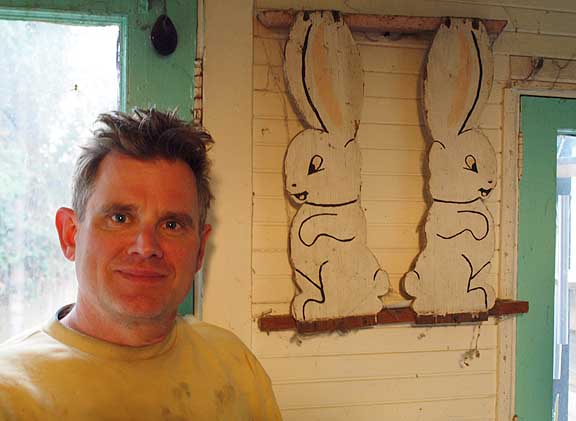 Tom Cramer, September 2009 Somewhat predictably, Tom Cramer's most recent show at Laura Russo Gallery is his best to date (and it ends October 31st). It is an inventive mixture of cosmic energy, German Romanticism and hard nosed discipline, which helps make his work both unique and exquisite. In fact, for at least the last decade Tom Cramer has been Portland's best selling artist and what's more with his art cars, murals and totem statuary, no artist is more ubiquitous. Perhaps no artist represents Portland's character more, being at once both hermetic and brash, Cramer embraces the contradictions of making "earthier" art that is anything if not transcendent. He's also a bridge between the Portland artists of the 60's and the latest tidal wave young émigrés and was way overdue for an interview with PORT. We interviewed him in his North Portland home and here's what Portland's all but official artist laureate had to say. 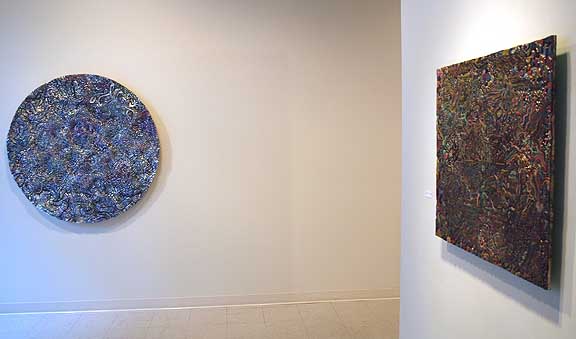
Tom Cramer's latest (showing me around the house) TC: A guy named Jack Eyerly gave me this Milton Wilson from 1957. As you can see it is slashed up in the bottom. It's because it was in this beatnik party and somebody go in a fight. So it's been that way since so I just kept it that way. JJ: Isn't it weird how wear on antique furniture ads value but damage degrades the value of artwork… even though it might be part of the art's story and life after it left the studio? In this case this is a painting utilized by real beatniks in a fight. TC: There is a Clifford Gleason over there JJ: Below that it's... TC: Walt Curtis JJ: To start, yours such a fixture in the scene… so lets begin with how you started as an artist? TC: If you go way back it begins with my musical background. My mother emphasized the arts and created an environment where I was surrounded by reproductions of Picasso, Braque, Klee and Winslow Homer as well. It was in my blood, that and classical music… and what I found in my early teen years I sort of plateaued in music and couldn't progress any farther. It was sort of a process of deduction where art was the area I got the best feedback. So in that way, I sort of fell into it. I had a really great high school art teacher and eventually I thought why go to regular college and I went to art school instead (the museum art school, now PNCA). I didn't really fit into art school though because I was always willful about doing things my own way. 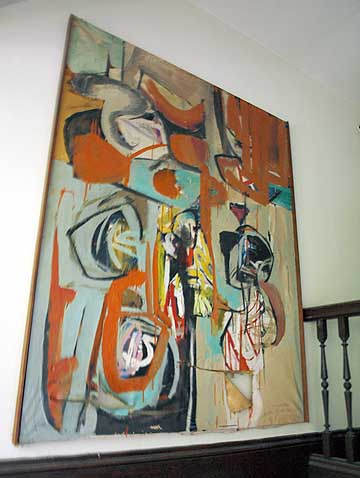 Milton Wilson, 1957 JJ: So somewhat autodidactic? TC: Well the one thing I really took away from art school was life drawing and art history. Everything else you kinda have to figure out on your self or you can read books. For that reason our school wasn't that big of a deal. When I went there I was the youngest kid and I still call it The Museum Art School, not the new name of PNCA. It's become a lot more serious. After the museum school I went to New York (Pratt) in the early 80's, which had the East Village scene and all that. By my last year at the Museum School there I kinda got it together and got straight A's and kinda conformed by actually doing what they wanted me to do. I'm glad I did because I actually learned a lot of discipline, it was boot camp. It wasn't fun when I went there, it was rigorous and if you didn't work you were kicked out. That was when they had all of the old school teachers like Manuel Izquierdo and George Johanson. The professors were beat generation and they taught modernism… so I kinda took modernism for granted as a completely acceptable way of seeing. The result was I never made a distinction between representational and non representational. 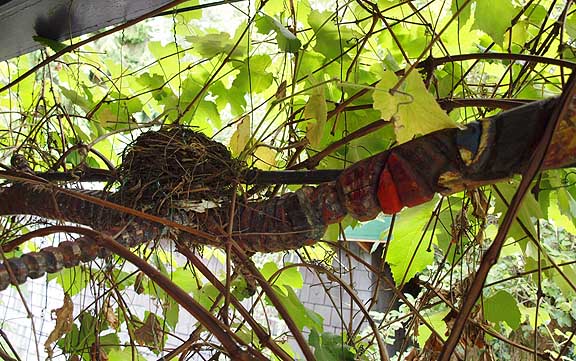 One of Cramer's early totems One of Cramer's early totemsJJ: If you grow up with something it stops being so loaded whereas a couple of generations before you abstraction was almost a crusade by people like Hilla von Rebay and her involvement in the Guggenheim museum's early days. Then by the 50's it is everywhere... even in people's kitchen wallpaper patterns. Suddenly, that becomes the orthodox position and you have to find a new periphery. TC: That reminds me of a conversation I had a few days ago, where the discussion was about FDR era art under the WPA. To make a long story short I preferred the art under the Eisenhower administration. It seemed like the lack of government involvement and a non allegorical art under Ike (Pollock, Still, de Kooning, Franz Kline) was a lot more libertine and experimental. It was heavy duty almost Ayn Randian patronage of the arts, also related to that Frank Lloyd Wright Taliesin style workshop and self sufficiency that made it so strong. It was pro-elitists yet paradoxically populist mentality that gave the Eisenhower era. I like those contradictions. 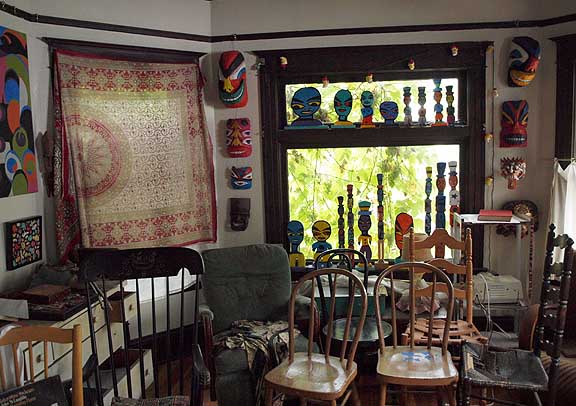 a room in Cramer's house JJ: For many the WPA was an age of development that lead to that later era of triumph for American art. Maybe the Eisenhower era was a time that was hungry for a very high level of achievement? They were willing to do the work because they had already been through the depression and WWII. Nobody apologized for trying to be the greatest artist on earth back then… I'm certain they knew it was an impossible to define label, but it spurred those artists on. They were a very serious, even Pollock… maybe especially Pollock because he really had nothing but art. If you think about Frank Lloyd Wright's patrons, most of them were not ridiculously wealthy. Instead they were people who had made a little money and wanted to do something forward thinking. TC: Just look at Frank Lloyd Wright's series of Usonian houses, it was like his own private WPA thing. Still a lot of Government sponsored art was bland and mediocre, a lot of 30's era artists just color me gray and it just sorta drags me down. 50's art has excitement. JJ: they were really whip smart back then… for example Bing Crosby. A lot of people now thing of him as this soft, smooth crooner but if you listen to his delivery and lyrics he's got an edge. On the surface it's calm and cool but there's always this deep commentary and tension underneath, his version of Thanks for the Memory is emotionally desolate to the point of going beyond bitterness…. He eats Beck for lunch. All of those rat pack guys, Dino, Frank, Sammy etc… there was this intensely cutting sarcasm that went along with being an entertainer. Noir fiction wasn't exactly happy stuff. TC: not at all, Noir film especially. American filmmaking in the 50's with Billy wilder and all of the German expressionist films influence American Noir. And that stuff directly influenced European cinema of the 60's. Bonnie and Clyde is essentially a remake of a European movie called Gun Crazy from 1948. They were really violent B movies that were low budget but were graphic, gritty depictions of modern urban life as it really was. JJ: I think that is where Tarantino has reinvigorated cinema by taking these low brow grind house genre films and by taking that genre both ultra seriously as an exercise in cinephile fun he's able to create genius level lowbrow chop socki kung fu movies like Kill Bill. He's a kick I the pants. Maybe that is what's wrong with our era, everyone's trying to niche market so much they become too aware of their constituency rather than challenging viewers. Tarantino asks viewers to hang in there with him, he doesn't repeat himself. He isn't playing to people's assumptions. 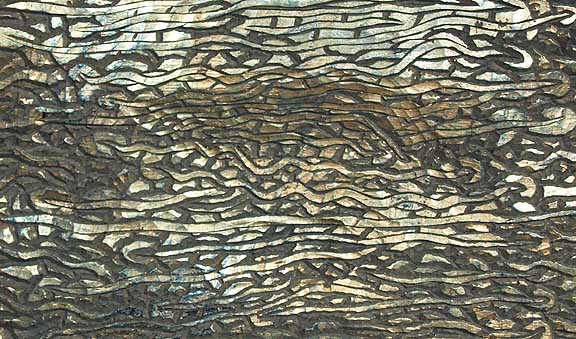 Wave (detail), 2009 TC: There's a lot to that, I agree that. That's why I was really affected by an interview with Gary Snyder, he's a native west coast person like me but he's got this great thing, he rejects this idea of "The Northwest" entirely and he prefers the term "Pacific Rim." "Northwest" is a Eurocentric term and really the Chinese, Japanese, and native tribes were much more influential on the west coast character. Snyder's idea is that people along the pacific ocean from Baja Mexico to Alaska …then down to Japan, China and Indonesia etc. share this sort of unifying oceanic mentality, less ably the self. And related to that he thinks too many people today worry too much about what other people think about them. Whereas you can isolate yourself and then a whole world of possibilities can open up for you without the influence of other's expectations. Paul Klee was into that… hanging out in the Swiss Alps, communing with nature. I'm skipping around a lot but what I'm getting at is that you are never lonelier than when you are around people. On the pacific rim of the United States you can get out into vast natural settings quite quickly. JJ: I experienced the opposite in New York the other week. If you are constantly measuring yourself by another person there is a certain existential dissatisfaction in that mode of being. Whereas in Portland I get the feeling they aren't necessarily trying to figure out who you are and what you want (it can be draining or you just act like a rock star and put up a cold reserve). In New York it's like everyone you interact with is tracking you, though some of them are very nice. I get that in LA too but its much more relaxed… in San Francisco, Portland or Seattle there is a license to be yourself. It's the most relaxed in Portland… people like Todd Haynes and Gus Van Sant can wander around without people throwing scripts, doing impromptu auditions, or ideas for scripts at them constantly. TC: In a similar vein, Mark Rothko, who is also a Northwest guy really identified it well. What he thought was horrible about the art world was what he called, "the competitive arena." In a similar way as I get older I don't want to be a part of that arena… not that I'm saying I'm better just that I want to get out of that box. I find it very bland and boring, it's much better just to work and let that process bring out original ideas. JJ: If you are calibrating your work for a perceived audience you are hedging on the work of more established artists… there is always somebody more established. Also, some artists try to control everything but it's your influences that control you, you don't control them… so the conscious choice to limit outside influences is about the only thing you can do. Being too self conscious is really being too conscious of what others think and it can be paralyzing. All successful artists, musicians, writers and filmmakers build up some walls when they have arrived because the din of outside interests can drown out imperatives that come from within. TC: That's a good quote, did you just think of that? JJ: Yeah… TC: I've been thinking along those lines a lot recently. I wonder sometimes when I'm talking to someone if I'm talking to the prescription drug they are on or the movie they just saw? People are so permeated with media influences you have to wonder who the real person is. JJ: its patterning and persona… you can find out who you really are when you get acquainted with the rhythms of your own heart, the sound of each breath and how you respond under pressure. It's kinesthetic, existential and has been explored in disciplines from eastern civilizations. Conversely, Postmodernism was sort of about being part of those trends and how we buy into things on a superficial level (related to globalism and marketing)... but what has invalidated that outlook is the fact that people can "just unplug." It's why craft has surged again, it's an engrossing activity. Getting over yourself to find yourself…. It's probably why you do such exhaustive work yourself. TC: Advertising really came into its own during WWII and then crazy invasive during the 70's. Most advertising people are extremely talented artists that simply wanted to make more money. I was pretty good friends with David Kennedy of Weiden + Kennedy, he was a student of mine. He was a great artist but he didn't pursue the fine art side… he was almost like Ed Ruscha. Ed Ruscha was almost like advertising, but he's also almost a Haiku of LA… like a reductive distillation of life in LA. Overall I reject the idea of northwest art. If you go to Iowa or Missouri you can find artists who look a lot like Louis Bunce or Carl Morris. There's this myth that Northwest art has this look but it doesn't, they are fine artists of course but those same styles were present everywhere. Grant Wood looks like Willamette valley. The stuff that does seem regionally unique like Ed Ruscha, paradoxically often ends up becoming international. Ernst Ludwig Kirchner looks like northwest art; with his alpine scenes… we don't have a proprietary claim on trees. 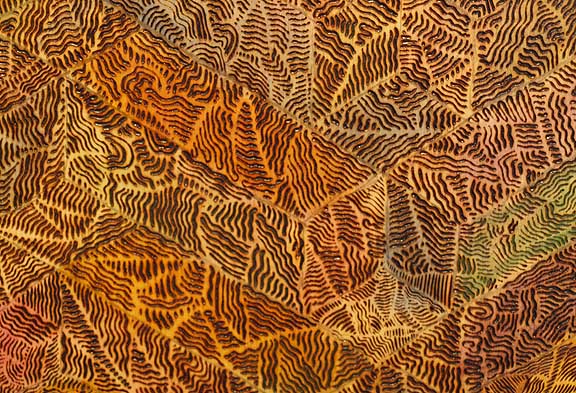 Multicolored Grotto (detail), 2009 JJ: Lets talk about your latest work, each show seems to become ever more detailed but your latest work, and particularly the wood burnings have this incredibly rich, burnished color scheme. It isn't as brash tonally like you're more pop related work, more like an old temple. How would you characterize the new work? TC: I've gotten to this point that I just accept any subjective interpretation that others bring to the work. I welcome the big tent interpretation approach. Some think the work is very pop abstraction, I don't understand that but that's fine. Other people see this LSD psychedelic 60's stuff… I don't necessarily think that but I can see how they would think that. First of all, I don't think it matters how I view them, but I won't evade the question. I see them as much earthier and more organic and more directly based on nature than the Woolley era stuff. That era was more related to outer space, ambient music like Klaus Schultz, Albert Hoffman, RD Lang Timothy Leary and other early intellectuals that experimented with LSD etc. I think people tend to view what I'm doing now through the lens of what I was doing 3-5 years ago. I do the same for other artists so it's fair. I can say they are both very chaotic or frenetic but at the same time very ambient. These latest wood burning works are bigger scale than they have ever been before. Overall to use an orchestral metaphor the last few shows are like a Beethoven sized 100 piece orchestra but this latest work is Bruckner level 140-160 pieces. The production levels, especially on the carvings have gotten even more produced. The analogy for the carvings is that each individual carved form is like a note and this time around those notes are subjected to even heavier studio production than before and that has a lot to do with layering. The more you look at this kind of detailed layering, the more you get out of it. Another artist who is onto what I'm onto is someone you are very familiar with, Laura Fritz. I saw her show at NAAU. Ill just be blunt, I'm just a guy off the street and I walk in and wonder ,"What is this stuff" but there is just a little something about it… maybe a insect moves in one corner or a flash of light that makes you reconsider and realize something else is going on there. The longer I spent with it the more 3-d and ambient and at the same time it became more disturbing. Eventually you are experiencing all of the emotions at the same time. It's fascinating. The viewer has to be discerning to get past the gate, spend some time and really soak in the experience, but because it isn't all immediately apparent there is always more. That's what I'm after… getting past the short bumper sticker experience. This latest work is increasingly interested in validating the viewer's experience, rather than me controlling the viewer's experience. In other words this latest work has become less manipulative. It's more Pacific Rim in that it is more open to interpretation; it's less European and more Asian in character. It's about enlarging the experience. You know Bruckner and Mahler composed all of that stuff in the Alps… they were kind of like titanic Hindu deities connecting Teutonic mythology to Hinduism and even Buddhism. It's strange but sometimes when you become extremely ego oriented you become ego less. JJ: If you are not trying to direct the experience the work becomes more porous to others. There is universality to being generous. Some work gives and gives and gives like Robert Irwin's Light and space and I feel other work like Luc Tuyman's is all take take take. To be open and generous is almost like a test pattern. TC: I think my work has become more libertarian; I'm not trying to please anyone. I'm certain there are those who want to dismiss it at decorative and wont look at it. But if someone doesn't look at it I can't do anything about it. JJ: That's the luxury of being an established artist. You've done the time, have a track record and your work is extremely visible with all the cars, ballet sets, murals and sculptures, not to mention the wall work in peoples private homes. Envy of that sort of thing is natural. TC: I believe that insecurity is one of the worst evils in the world… everyone's unique so just be yourself. At one time I was concerned that I couldn't do portraits because that wouldn't "be my work" and I had a teacher that disabused me of that idea. He said, "oh no, it's always going to be your work, no matter what it is you do," and it changed my life. JJ: Yeah, you just have to be mean what you do by finding the "inner necessity" of your art… to use Kandinsky's term TC: I know what you are onto there. To use a classical music again as an example… a lot of people think that Brahms or Rachmaninoff are the most difficult things to play on Piano… but they aren't… you can cover up things up with additional embellishments. Mozart is actually the most difficult because there is no where to hide. What I'm trying to get at here is that I want my work to look easy, even though it takes a lot of effort to make them look that polished and ambient. I'm trying to provide solutions to the crazed world out there… that troubled, apocalyptic world we tend to live in these days. I'm not interested anymore in reflecting it; I'm interested in proposing a solution. Maybe that is utopian but it's better than bringing others down. Posted by Jeff Jahn on October 30, 2009 at 15:51 | Comments (1) Comments Thanks Jeff and Tom for sharing a stimulating conversation. My first exposure to Tom was a talk he was giving to art students at Laura Russo and I fell in love with the way he talked about his work and art and influences. This was before I had really looked at his art. I so enjoy his weaving philosophy and music and history in his soemwhat jazzlike scat fashion Posted by: Charles Post a comment Thanks for signing in, . Now you can comment. (sign out)
(If you haven't left a comment here before, you may need to be approved by
the site owner before your comment will appear. Until then, it won't appear
on the entry. Thanks for waiting.)
|
| s p o n s o r s |
 |
 |
 |
 |
 |
 |
 |
 |
 |
 |
 |
 |
 |
 |
 |
 |

|
Site Design: Jennifer Armbrust | • | Site Development: Philippe Blanc & Katherine Bovee | |


![[TypeKey Profile Page]](http://www.portlandart.net/nav-commenters.gif)